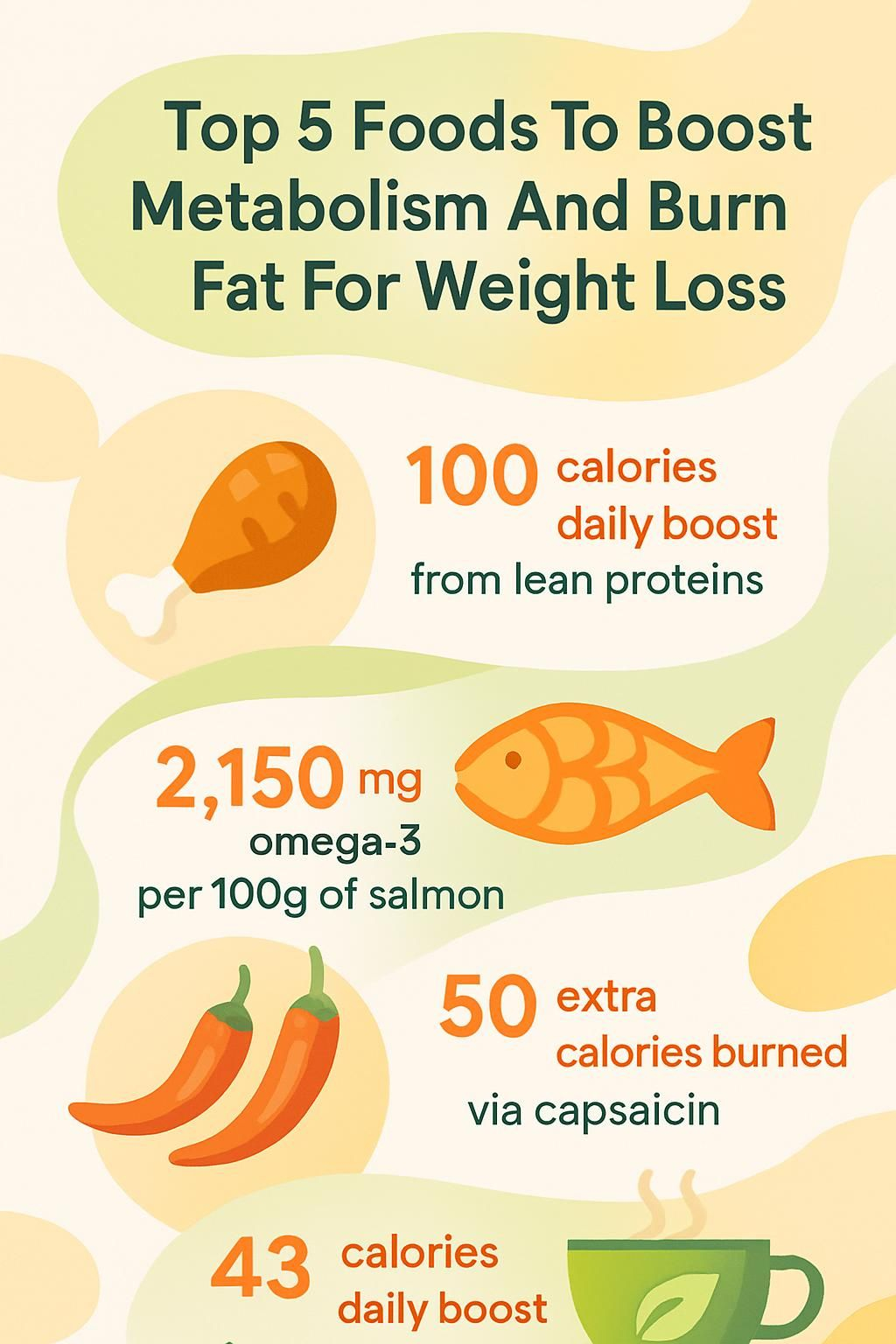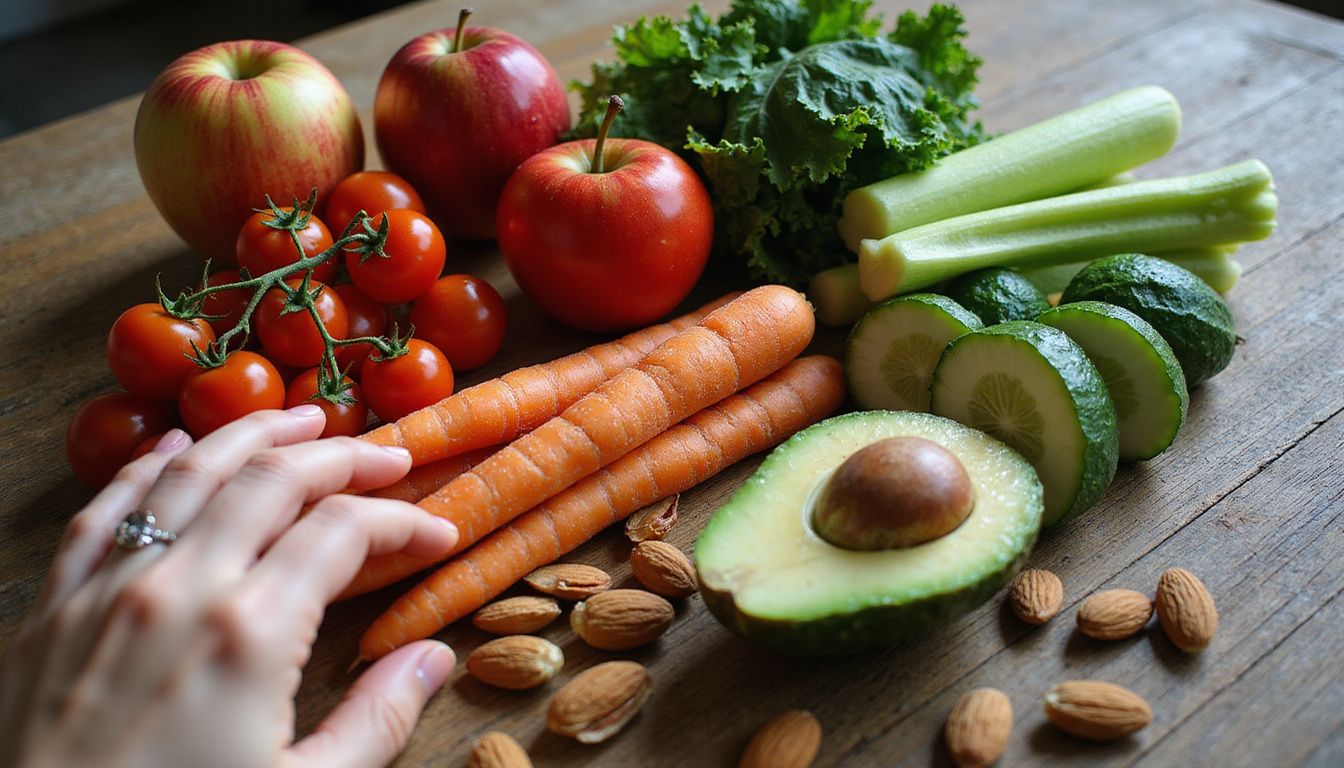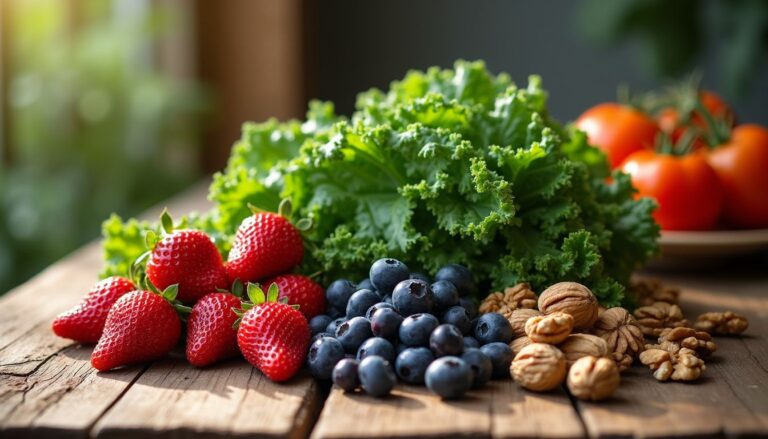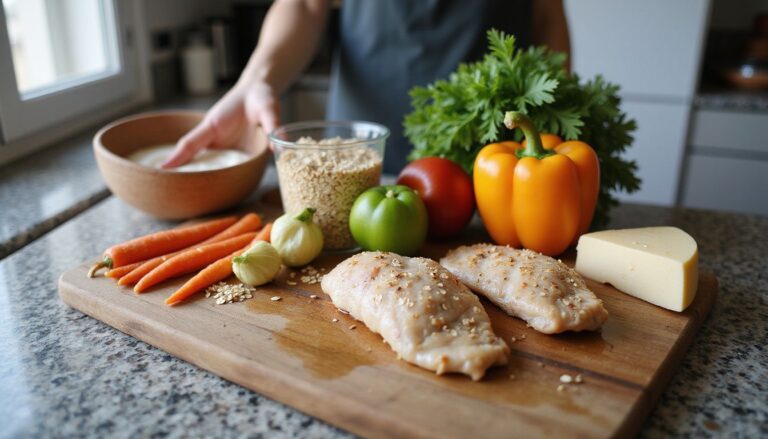Top 5 Foods To Boost Metabolism And Burn Fat For Weight Loss
Our Nutrition Assistant AI Suite will transform your body. You will lose fat, get toned, and build muscle. Gain confidence and optimal health.
Struggling with weight loss can drain your energy and motivation. The good news is that certain foods can help boost your metabolism, which is the energy your body uses every day. Protein-rich meals, hot peppers, and smart drinks like green tea can nudge your body to burn more calories, even at rest.
This guide breaks down five fat-fighting foods and how to use them. You will learn simple steps, quick tips, and the science behind each pick, so you can act today and see steady progress.
Key Takeaways
- Lean proteins such as chicken, turkey, and eggs raise calorie burn through the thermic effect of food, often adding close to 100 calories per day.
- Fatty fish like salmon and mackerel are rich in omega-3 fatty acids, which support fat oxidation; salmon has about 2,150 mg omega-3 per 100 grams.
- Hot peppers contain capsaicin that can increase thermogenesis, helping you burn up to 50 extra calories daily in some studies (Yoshioka M et al., 1995).
- Green tea blends caffeine with catechins to boost metabolism, adding roughly 43 calories burned per day when used with a healthy diet.
- High-fiber foods, including oats and beans, improve fullness and calorie burn; eating 25 grams of fiber daily links to lower obesity rates in CDC data.

How does metabolism impact weight loss?

Metabolism is how your body turns food and drinks into energy. Your basal metabolic rate, often called BMR, is the energy you burn at rest. A higher BMR means you use more calories all day, even while sitting.
Certain foods increase calorie burn for a few hours through the thermic effect of food. This is the energy your body spends digesting and absorbing nutrients. Protein needs more energy to process than carbs or fat, so protein-rich foods can raise daily calorie use. Building and keeping muscle also helps keep metabolism higher.
Small food changes, such as adding lean protein and fiber, can increase the number of calories your body burns each day. This supports weight management and a steadier weight loss journey.
Key factors that influence metabolism
Several core factors shape how quickly you burn energy. Understanding these helps you pick habits that support consistent progress.
How does age affect metabolism?
Metabolism tends to slow with age. Muscle mass often drops 3 to 8 percent per decade after 30, which lowers calorie burn at rest. Hormone levels, including growth hormone and testosterone, also decline with age and influence muscle building and maintenance.
If activity does not increase, calorie needs may fall by about 150 calories every ten years. Strength training and adequate protein can offset these changes and help you keep a steady metabolic rate.
“Age does not have to define your energy level—regular exercise and smart food choices can make a real difference.”
Maintaining muscle becomes even more important for long-term weight management.
What role does muscle mass play in metabolism?
Muscle is active tissue. It uses more energy than fat tissue, even when you rest. One pound of muscle may burn around six calories daily, compared with about two for a pound of fat.
Resistance training increases and preserves muscle. That raises your metabolic rate during the day and even after workouts. Eating lean protein, like chicken, turkey, or eggs, supports muscle repair and growth. More muscle usually means easier weight control over time.
How do activity levels influence metabolism?
Movement boosts calorie burn during activity and afterward. This afterburn is called excess post-exercise oxygen consumption. Even short bursts of movement like taking the stairs can lift daily energy use.
Regular cardio and strength training raise resting metabolic rate compared to a sedentary lifestyle. Many people also notice better appetite control and a clearer mind on days they move more.
How do genetics affect metabolism?
Genes affect how quickly you burn energy and where you store fat. Thyroid function, muscle potential, and how you respond to certain foods can all be influenced by genetics.
Two people can eat the same diet and exercise the same amount, yet lose weight at different speeds. If changes come slowly despite good habits, your genes may be part of the reason. You can still make progress with consistent training, protein intake, and sleep.
Top 5 foods to boost metabolism and burn fat
The right foods can help your body burn more calories and feel full longer. These superfoods to boost your metabolic rate also make meal planning simpler.
Why are lean proteins important for metabolism?
Your body spends more energy digesting protein than it spends on fat or carbohydrates. This process is called the thermic effect of food. Because protein has a higher thermic effect, it can slightly increase your metabolic rate.
Lean proteins such as chicken, turkey, and eggs are low in fat and rich in amino acids that build muscle. More muscle means more calories burned at rest. Eating protein at each meal can also stabilize blood sugar and help control appetite.
Studies suggest high-protein diets may add up to about 100 extra calories burned per day.
Which lean proteins boost metabolism the most (chicken, turkey, eggs)?
Chicken, turkey, and eggs are reliable sources of protein that support fat loss and daily energy use. Here is how they help.
- Chicken breast is high in protein at roughly 31 grams per 100 grams, and it supports thermogenesis more than fats or refined carbs.
- Turkey offers protein plus iron and selenium, minerals that support enzymes involved in metabolism.
- Eggs contain complete protein, about 6 grams per large egg, which increases fullness after meals.
- Lean meats like chicken and turkey help maintain muscle during a calorie deficit, which supports a higher metabolic rate.
- Having eggs at breakfast can curb appetite across the day, which may support better calorie control.
- High-protein foods increase thermogenesis by roughly 15 to 30 percent, compared with 0 to 3 percent for fats and 5 to 10 percent for carbs.
- Swapping a sugary cereal for scrambled eggs can reduce midmorning hunger and simplify portion control.
These foods also provide vitamin B12, which helps your cells turn food into usable energy.
How do Greek yogurt and cottage cheese support metabolism?
Greek yogurt and cottage cheese pack high protein with modest fat. Since protein has a higher thermic effect, your body spends more energy digesting it. One hundred grams of Greek yogurt has about 10 grams of protein, while cottage cheese has around 11.
Many varieties include probiotics, which support gut health. A healthier gut may help with appetite regulation and fat loss. Try Greek yogurt with berries as a snack. It feels filling and makes it easier to avoid high-calorie treats.
Both foods are simple to add to salads, smoothies, and grain bowls, which keeps your protein intake steady.
Why is fatty fish good for metabolism?
Fatty fish like salmon, mackerel, sardines, and tuna deliver omega-3 fatty acids. These fats support thyroid hormones, reduce inflammation, and may improve how your body burns fat for energy.
People who eat fatty fish two to three times per week often see better fat oxidation in clinical trials. Fish oil has also been linked to lower body fat in some groups. You may notice improved recovery after workouts and fewer late-day cravings.
Replacing some red meat with salmon or mackerel can support an active lifestyle and steady calorie burn.
Which fatty fish are high in omega-3 fatty acids?
Several fish provide strong omega-3 levels that may support a healthy metabolic rate.
- Salmon has about 2,150 mg omega-3 per 100 grams and supports heart health and steady energy.
- Mackerel provides roughly 4,580 mg per 100 grams and may help reduce body fat.
- Sardines offer around 1,480 mg per 100 grams and also supply calcium and vitamin D.
- Herring contains about 2,366 mg per 100 grams and works well fresh or pickled.
- Rainbow trout gives around 983 mg per 100 grams and cooks quickly for easy meals.
- Tuna, especially white tuna, provides about 733 mg per 100 grams when eaten fresh or canned in water.
- Anchovies pack about 2,113 mg per 100 grams and support brain function along with fat burning.
Adding fatty fish two or three times weekly can help you meet your needs for essential fats while supporting metabolism and recovery.
How do chili peppers increase calorie burn?
Hot peppers like jalapeños and cayenne contain capsaicin, the compound that brings heat. Capsaicin increases thermogenesis, which raises body temperature and boosts energy use after eating.
Meals that include capsaicin can add up to about 50 extra calories burned per day in some studies. The increase is small but can build over weeks and months. Spicy foods may also reduce appetite, which helps you eat fewer calories later in the day.
What is capsaicin and how does it boost thermogenesis?
Capsaicin is the natural heat compound in hot peppers. It activates thermogenesis, the process of making heat in the body. During thermogenesis, your body burns extra calories as it generates heat from fat tissue and other energy sources.
Foods with capsaicin may also lower appetite while increasing post-meal calorie burn. Research suggests hot meals with capsaicin can raise metabolism for several hours[1]. Many soups and stir-fries include peppers for both flavor and metabolic support.
…
[1] Yoshioka M et al., “Effects of red-pepper diet on the energy metabolism in men,” J Nutr Sci Vitaminol (Tokyo), 1995;41(6):647-56.
How do green tea and coffee enhance metabolism?
Green tea and coffee contain caffeine, which stimulates the central nervous system. This stimulation increases energy use, even while resting. Drinking three to four cups of coffee per day may add up to 100 calories burned for some adults.
Green tea also provides catechins, plant compounds that work with caffeine to increase fat oxidation. Choosing tea or black coffee instead of sugary drinks lowers calorie intake while supporting a higher metabolic rate.
How does caffeine in green tea and coffee affect fat burning?
Caffeine can raise calorie burn by about 3 to 11 percent for short periods. It also increases the use of stored fat for energy, called fat oxidation. Many people feel more alert after coffee or tea, which can help workouts feel easier.
Green tea offers moderate caffeine plus catechins for a gentle boost. Coffee contains more caffeine and may help with appetite control for some people.
What role do catechins in green tea play in fat loss?
Catechins support thermogenesis and help your body burn slightly more calories per day. Research estimates about 43 extra calories burned daily when green tea is used with healthy eating and exercise. Catechins also reduce how much fat is absorbed after a meal.
Two to three cups of green tea daily are enough for most benefits without excess caffeine. Pairing green tea with a high-protein snack, like Greek yogurt, can be a simple routine.
Why are fiber-rich foods important for metabolism?
Fiber slows the absorption of sugar and fat, which helps keep blood sugar steady. Foods high in fiber include beans, lentils, chickpeas, broccoli, fruit, and whole grains. Since fiber takes more effort to digest, it modestly increases calorie burn through the thermic effect of food.
Prebiotic fibers feed healthy gut bacteria. These bacteria produce short-chain fatty acids, which may help regulate appetite and support fat burning. Eating at least 25 grams of fiber daily is linked to lower obesity risk in CDC reports.
Which whole grains and fruits help boost metabolism?
Whole grains and fruit add fiber and nutrients that support energy use and fullness.
- Oats provide prebiotic fibers that feed gut bacteria and support steady energy.
- Brown rice delivers magnesium and B vitamins that your cells use for energy production.
- Quinoa offers complete protein, which supports muscle and a higher metabolic rate.
- Barley contains soluble fiber that increases fullness and may reduce overeating.
- Apples supply pectin, a fiber that helps regulate blood sugar.
- Blueberries provide antioxidants and fiber that support health and metabolic activity.
- Grapefruit may help with insulin control and offers low calories for its volume.
- Pears contain prebiotic fibers that support a healthy gut environment.
- Kidney beans add plant protein, fiber, magnesium, and iron for steady energy use.
- Bananas provide potassium and resistant starch that can support post-meal calorie burn.
Simple swaps, like oatmeal for refined cereal or fruit for dessert, make it easier to include these foods daily.
What are some additional metabolism-boosting foods?
Beyond protein, fish, tea, peppers, and fiber, a few more foods can support fat loss. These options are easy to add to meals and snacks.
How do nuts and seeds support metabolism?
Nuts and seeds offer healthy fats, protein, fiber, and minerals like magnesium. Magnesium supports hundreds of enzyme reactions that help produce energy. Protein from nuts and seeds helps build or maintain muscle, which burns more calories than fat tissue.
Healthy fats support fat oxidation and may reduce inflammation. A small portion of mixed nuts or seeds between meals can control hunger and steady energy. Fiber in nuts and seeds also acts as a prebiotic, supporting gut health and efficient digestion.
What benefits do ginger and cinnamon offer for metabolism?
Ginger is a warming spice that supports thermogenesis, which can raise calorie burn a little. It may also increase satiety, so you feel less hungry.
Cinnamon helps keep blood sugar steadier by supporting how your cells use glucose. Better blood sugar control can reduce cravings and support weight management. Both spices mix well into smoothies, oatmeal, and stir-fries.
Can dark chocolate help burn fat?
Dark chocolate contains flavonoids, antioxidants that may improve insulin sensitivity and reduce inflammation. Better insulin sensitivity can mean less fat storage and more steady energy use.
There is also a small amount of caffeine and theobromine, which can nudge metabolism. Choose a small square with at least 70 percent cocoa. This can satisfy cravings and help you avoid higher-calorie desserts.
How does grapefruit affect metabolism?
Grapefruit contains compounds that support fat breakdown and appetite control. In some studies, people who ate half a grapefruit before meals lost more weight than those who did not.
This fruit is high in water and fiber, so it fills you up without many calories. Grapefruit has a low glycemic index and may improve insulin sensitivity, which supports using food for fuel rather than storing it.
How do these foods help burn fat?
These foods increase calorie burn, raise fullness, and help your body use stored fat for energy. Over time, these small boosts can support lower body fat.
How do these foods increase calorie expenditure?
Protein-rich foods, Greek yogurt, and fatty fish take more energy to digest, which raises thermogenesis. Protein can increase metabolic rate up to about 30 percent after eating, while carbs and fats are lower.
Spicy foods activate heat production through capsaicin. Tea and coffee stimulate the nervous system, which can add calories burned at rest. Whole grains and legumes also support fat oxidation and steadier energy across the day.
How do they promote satiety and reduce overeating?
Protein triggers hormones that signal fullness to your brain, which helps you eat fewer calories later. Fiber slows stomach emptying and keeps blood sugar steady, which reduces cravings.
Meals that include 20 to 30 grams of protein and at least 5 grams of fiber are a helpful target for appetite control. A simple breakfast of cottage cheese with fruit can reduce the urge to snack before lunch.
How do they enhance fat oxidation?
Protein, green tea, and coffee support pathways that use stored fat for energy. Capsaicin activates enzymes that help break down fat during the day.
Omega-3 fats in fish improve how your cells use fat rather than store it. Many people notice better fullness and fewer cravings when meals include these foods, which supports a steady drop in body fat.
How can I incorporate these foods into my diet?
Small, repeatable steps work best. Start with one change per meal or snack and build from there.
How to add lean proteins to every meal?
- Choose eggs or low-fat Greek yogurt at breakfast to support muscle and satiety.
- Use grilled chicken breast or turkey slices in salads, wraps, or sandwiches.
- Plan fish like salmon or tuna for dinner three times a week to add omega-3 fats.
- Pick cottage cheese as a snack; its slow-digesting protein helps control hunger.
- Add cooked beans or lentils to soups and stews for protein and fiber.
- Swap refined grains for quinoa or brown rice to pair with lean meats.
- Use tofu or tempeh in stir-fries for meatless protein on busy nights.
- Pack hard-boiled eggs, a piece of fruit, or roasted chickpeas for portable snacks.
Steady protein across the day supports muscle, boosts calorie burn, and helps you feel full.
What are good alternatives to sugary drinks?
- Replace soda with water infused with lemon, orange, or berries for flavor without sugar.
- Choose unsweetened green tea for caffeine and catechins that support fat oxidation.
- Enjoy black coffee in moderation to increase daily energy expenditure.
- Pick lightly sparkling mineral water and add lime juice for a fresh taste.
- Try herbal teas like peppermint or chamomile for hydration without added sugar.
- Use low-fat milk or fortified plant milks to support nutrient needs, including iodine.
- Blend fruit smoothies at home with whole fruit, Greek yogurt, and ice.
- Drink plain coconut water without added sugars after workouts for electrolytes.
- Have cold water often; it may slightly raise calorie burn as your body warms it.
Swapping sugary drinks for these options can stabilize energy and reduce daily calories without feeling deprived.
What are healthy snack options to boost metabolism?
- Hard-boiled eggs for quality protein that supports muscle and fullness.
- Greek yogurt with berries for a protein and fiber combo that steadies blood sugar.
- A small handful of almonds or walnuts for healthy fats and fiber.
- Apple or pear slices with natural peanut butter for fiber and lasting energy.
- Cottage cheese dip with carrots or celery for extra protein and crunch.
- Edamame for plant-based protein that raises the thermic effect of food.
- Spicy roasted chickpeas for fiber and a capsaicin boost.
- Oatmeal cups with chia seeds for complex carbs and steady appetite control.
Prepping two snacks ahead of a busy day helps you skip vending machine choices and stay on track.
How to include more spicy foods in recipes?
- Add chopped jalapeños or serrano peppers to salads, eggs, or soups.
- Mix cayenne or red chili flakes into marinades and sauces for heat.
- Top grilled chicken, turkey, or fish with your favorite hot sauce.
- Stir fresh ginger or a touch of wasabi into stir-fries for a warming effect.
- Use spicy salsa on cottage cheese or Greek yogurt for a quick savory snack.
- Cook with curry blends that include turmeric and black pepper for flavor and warmth.
- Blend garlic and chiles into dips for vegetables or whole-grain crackers.
- Try meals from Thai, Mexican, or Indian cuisines to increase spice variety each week.
These small tweaks add flavor and may lift calorie burn without adding many calories.
What are other ways to support a healthy metabolism?
Food is only one part of the picture. Daily movement, hydration, quality sleep, and stress control keep metabolism steady.
How does regular exercise support metabolism?
Strength training builds muscle, which boosts resting calorie burn. Cardio like brisk walking or cycling raises energy use during and after the workout.
Regular activity improves insulin sensitivity and body composition. In one study, 150 minutes of moderate exercise per week raised metabolic rate by about 7 percent. Movement also supports better sleep and mood, which helps you stay consistent.
Why is staying hydrated important for metabolism?
Water carries nutrients and oxygen to cells so they can make energy. Even mild dehydration slows metabolism and makes you feel sluggish.
Drinking about 16 ounces of cold water can raise resting metabolic rate for over an hour in some studies. Water also supports fat breakdown, called lipolysis, which helps free fat for energy.
How does adequate sleep affect metabolism?
Adults need 7 to 9 hours of sleep to support healthy metabolism. Too little sleep raises ghrelin, the hunger hormone, and lowers leptin, the fullness hormone.
Poor sleep also harms glucose control, which can push the body to store more fat. Good sleep makes healthy eating and regular exercise feel easier.
How does managing stress improve metabolism?
High stress raises cortisol, a hormone that can slow metabolism and increase belly fat over time. In a study from Ohio State University, women who reported stress burned 104 fewer calories after a high-fat meal than those without stress.
Short breathing breaks, a quick walk, or a few minutes outdoors can help. These habits improve sleep, reduce cravings, and support steady weight loss. If stress feels unmanageable, talk with a healthcare professional for guidance.
What are common myths about metabolism and weight loss?
Misunderstandings can stall your progress. Here are facts that let you focus on what works.
Does metabolism significantly slow with age?
Metabolism declines slowly with age, often about 1 to 2 percent per decade after 30. The main cause is muscle loss, not age itself.
Resistance training and protein-rich meals help preserve muscle and maintain calorie burn. Many people feel more energetic when they lift weights and eat enough protein.
Does eating small meals frequently boost metabolism?
Eating more often does not significantly raise metabolism. Total calories and food quality matter more than meal frequency.
Choose the schedule that helps you control appetite and stick to your plan. Some do best with three meals, others prefer smaller meals. Either approach can work.
Can certain foods magically burn fat?
No single food melts fat. Green tea, hot peppers, and fiber-rich foods offer small boosts that add up with time. For example, green tea can raise calorie burn by a few percent over 24 hours in research published in the American Journal of Clinical Nutrition.
Lasting weight loss still depends on a calorie deficit, regular activity, and sleep. Use these foods as helpful tools within a healthy plan.
Conclusion
Choosing the right foods can help boost your metabolism and support steady weight loss. Lean proteins, fatty fish, Greek yogurt, chili peppers, and green tea each add a small edge that grows with consistency. Use them across your week, stay active, drink water, and protect your sleep. Small steps today can build a faster, healthier metabolism over time.
FAQs
1. What are the top foods to boost metabolism for weight loss?
Foods that support metabolism include lean poultry, green tea, whole grains, chili peppers, and Greek yogurt. These foods can help your body burn more calories and support overall health.
2. How does incorporating metabolism-boosting foods help with fat loss?
Incorporating metabolism-boosting foods into your diet can increase calorie burn and promote fat loss. For example, chili peppers contain capsaicin, which may raise metabolic rate, while whole grains require more energy to digest compared to refined grains.
3. Can eating these foods improve overall health as well as metabolism?
Yes, many metabolism-boosting foods also improve overall health. Lean poultry provides protein for muscle repair, green tea offers antioxidants, and Greek yogurt supplies probiotics for gut health.
4. Is there scientific evidence supporting the benefits of these foods for metabolism?
Research supports the role of certain foods in boosting metabolism. For instance, studies show that green tea can increase energy expenditure by about 4 percent, and protein-rich foods like lean poultry can raise metabolic rate due to the thermic effect of food. Incorporating these foods as part of a balanced diet can help with weight management and overall health.







